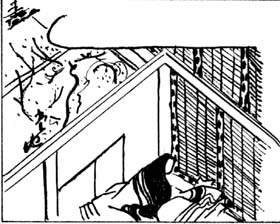|
||
 |
||

(C)2001 Japanese Architecture and Art Net Users System. No reproduction or republication without written permission.
掲載のテキスト・写真・イラストなど、全てのコンテンツの無断複製・転載を禁じます。
|
||||||
| fukinuki yatai 吹抜屋台 | ||||||
| KEY WORD : art history / paintings | ||||||
| A compositional technique used to depict a residential interior. The technique involves rendering a building without a roof and ceiling so that the viewer looks inside from above. It is widely employed in *yamato-e やまと絵 in the Heian and Kamakura periods, especially in handscrolls (see *emaki 絵巻) illustrating classic novels, monogatari-e 物語絵, which include many scenes set inside aristocratic residences. Such images were usually depicted either in the built-up paintings *tsukuri-e 作り絵 or in monochrome *hakubyou 白描 techniques. The earliest extant use of the technique can be found in The Biography of Prince Shoutoku Shoutoku Taishi e-den 聖徳太子絵伝 (1069) which originally decorated the walls of the Picture Hall, Edono 絵殿 at Houryuuji 法隆寺 (Tokyo National Museum). The position of the imaginary viewer tends to become higher in Kamakura period compositions in order to allow the artist to depict wider interior spaces. Even after the Muromachi period, this technique was used in the works following in the tradition of yamato-e style and themes. | ||||||
| |
||||||
 |
||||||
| REFERENCES: | ||||||
| EXTERNAL LINKS: | ||||||
| NOTES: | ||||||
(C)2001 Japanese Architecture and Art Net Users System. No reproduction or republication without written permission. 掲載のテキスト・写真・イラストなど、全てのコンテンツの無断複製・転載を禁じます。 |
||||||